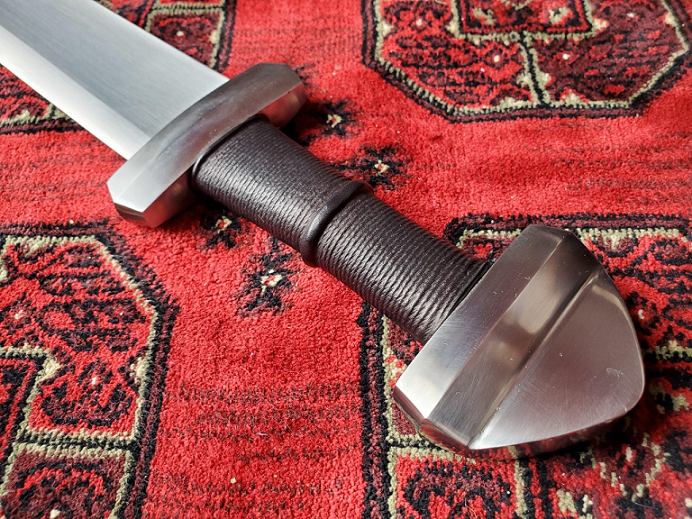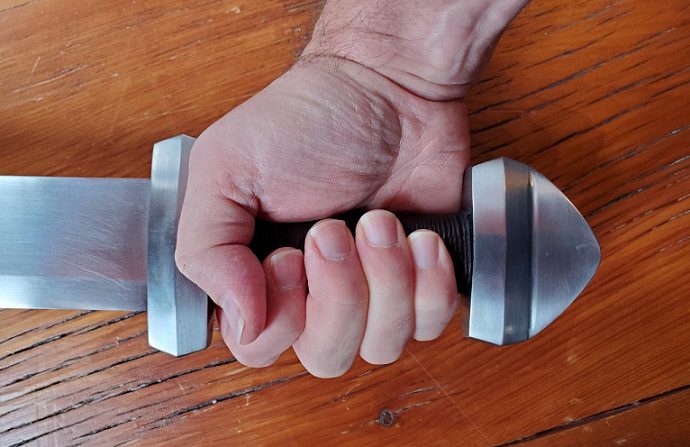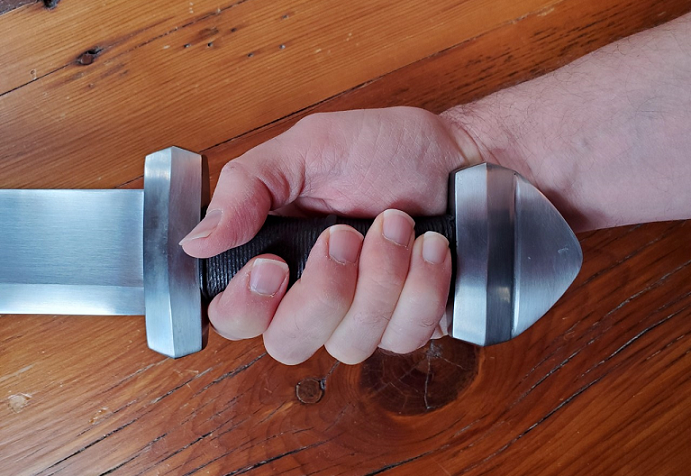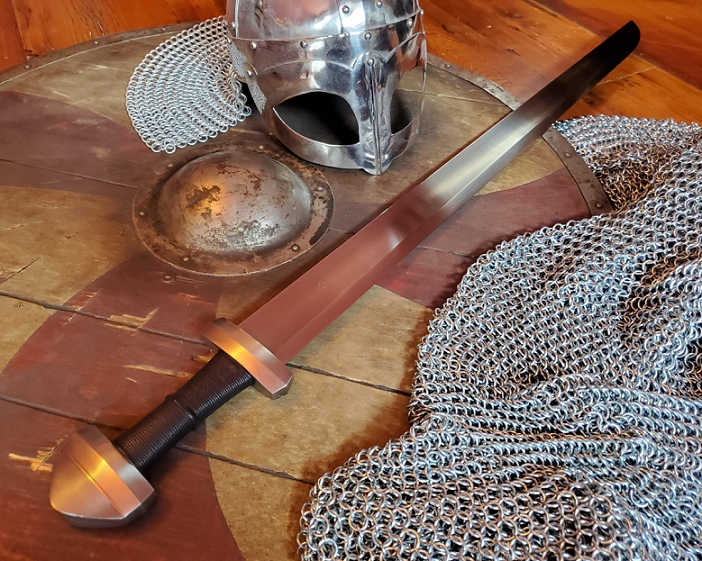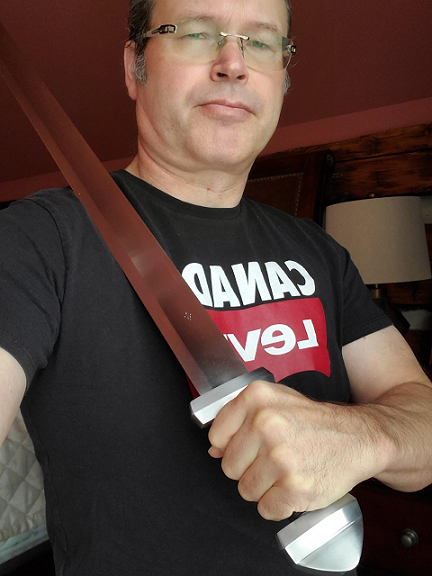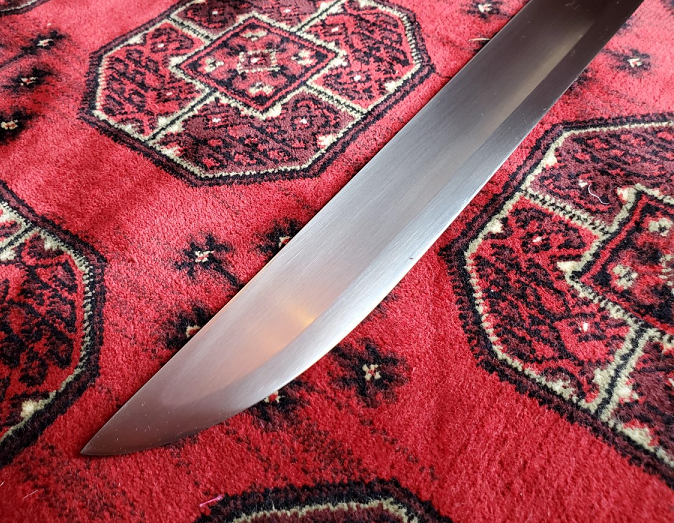I don’t usually review Albions, because most of them have already been reviewed and usually there are no big surprises (I mean that as a compliment). However, the Berserker is a bit unusual and (other than some Youtube reviews) it has not got a lot of attention. A couple of people asked me to review mine, so, by popular demand, here goes…
Introduction
If you’re new to Viking swords, you might be surprised that many of them were single-edged. This style of Viking sword was particularly popular in Norway and is also found where the Norse were active, such as the coastal / island regions running along the North/West of Scotland and North/East Ireland. Jan Petersen (the great categorizer of Viking swords) reported that these tend to be a bit heavier than the usual Viking sword, and typically had the ‘triangular hat’ family of upper guard/pommels (e.g., types B, C, H) accompanied by canoe-shaped lower guards (corresponding to the cross in medieval swords). Fun fact: some consider this type to be a transitional form from the dark age long seax to the medieval falchion, although (if I recall correctly) that is apparently debated. Considering its popularity, this type is rather poorly represented among modern replicas. (I can only think of three current production swords, including the one reviewed here).
Overview: the Albion Berserker
This model has been around for years but I don’t think it is one of their more popular models. It never made high enough on my list to merit ordering a new one and waiting for year, but it intrigued me enough to watch out for a 2nd hand model, with the one in question finally coming up for sale early this year (2020). I ended up waiting months to get it due to COVID-related shipping delays, but it was worth the wait.
Besides the obvious single edge, this sword has several other interesting characteristics. First the back of the blade has a very thick spine almost to the tip, continuing to a very wide fuller, and then a chisel-like cutting edge. Second, Albion and/or Peter Johnsson chose to give it a type B pommel, which is an earlier form and seems to be less common than the later type C and H. Perhaps Albion did this for variety, since their ‘Hersir’ model has the type H. Type B has an oddly angular profile when viewed from the side (sort of vase shaped) whereas C and H are rectangular & triangular respectively, with H more rounded at the edges. There are other subtle differences. The Albion pommel is is correctly peened (not rivetted like type H), although I think that technically the B was a two-piece. Likewise the lower guard is quite angular. The overall look is quite striking: the blade is quite curvilinear, whereas the handle furniture is very angular and surprisingly modern looking (yet historically correct).
Statistics:
Total Length: 36 inches.
Blade Length: 29 5/8”
Blade width: 1 29/32”
Blade thickness: 3/16” at initial spine, tapering linearly to 3/32” near tip.
‘Cross’ width: 3 ¼”
‘Pommel’ width: 2 ¾”
Pommel/guard height: 1 13/16”
CoG: 3 3/4”
Proximal Harmonic Node: middle of the grip
Distal Harmonic Node (optimal striking point): ~6” from tip
Distal Pivot Point: right at the tip
Weight: sorry, can’t find my usual scale (a digital fishing scale), but the Albion/KoH figures feel right: 2.6 lbs.
Fit and Finish
Well, its an Albion, so what do you expect. Everything is tight and nicely done, from the satin finish to the grip (single central riser with overwrap impression the leather) and the overall proportions. I don’t see any secondary bevel on the blade. I’m particularly impressed by the fuller. My meagre knowledge of blade smithing says that wider fullers are harder to make than narrow fullers, whether by chisel or power tools. I’ve owned some high end type Xs that had uneven fullers. This is the widest fuller I have ever seen, and yet its perfect. This speaks to Albion’s method of CNC milling followed by hand finishing.
Handling & Performance.
Always my favorite part to evaluate because it can be so much affected by subtle features. Going by the numbers (weight, CoG etc), one can predict that this relatively compact sword has a chunky feel, but very maneuverable. No surprise, it does not have the familiar dynamic feel of a two-edge Viking sword but rather feels like a big machete or butcher blade. The tip is easy to control (I guess owing to the pivot point near tip). This sword can be held in either the hammer grip or handshake grip (see below), although the hammer grip presses the edge of my palm against the angular upper guard. My main complaint is that all those angles on the pommel become uncomfortable when transitioning between these grips (as I like to do), but of course this can be mitigated by wearing a glove. Despite the easy tip control, thrusting is not intuitive with this asymmetric blade and grip design, but in the hammer grip one could powerfully leverage an upward thrust beneath the opponents shield toward the groin, or around the right side of the shield into the abdomen (not that I have plans to try that).
Most obviously, this is a chopper. The curving tip and forward optimal striking point would make this idea for tip slices, although the whole blade is quite impervious to vibration and should cut well all along. I have no intentions of testing this on such an expensive blade, but if you look online you can find a you-tuber happily chopping a log with this sword. It would interesting to see this sword go through the ‘kill test’ they have on ‘Forged in Fire’. I don’t think this blade would pass entirely through a pig carcass in one swing -its not that big- but I’m confident it would bit deep on every cut.
Conclusions
This sword may not be to everyone’s taste, but it’s a unique and important piece that belongs in the collection of anyone who is really serious about Viking swords. I’d like it a bit better with a type H pommel, but overall I think it’s a very fine piece, with some attractive features.
Regards, JDC
PS - Happy New Year!

